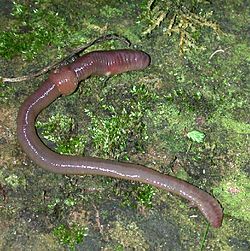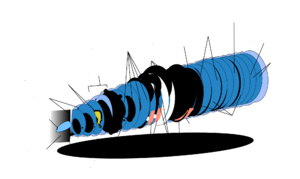Lumbricus terrestris facts for kids
Quick facts for kids Lumbricus terrestris |
|
|---|---|
 |
|
| Scientific classification | |
| Kingdom: | |
| Phylum: | |
| Class: |
Clitellata
|
| Subclass: | |
| Order: |
Haplotaxida
|
| Family: |
Lumbricidae
|
| Genus: |
Lumbricus
|
| Species: |
L. terrestris
|
| Binomial name | |
| Lumbricus terrestris Linnaeus, 1758
|
|
Lumbricus terrestris is a big, reddish earthworm. It originally came from Europe. But now, you can find it all over the world because people moved it to new places. In some areas, it's seen as a problem because it competes with worms that naturally live there.
In most of Europe, this is the largest earthworm you'll find. It can grow to about 20 to 25 centimeters (8 to 10 inches) long when stretched out.
What We Call Them
Since this worm is so well-known, it has many different names. In Britain, people often call it the common earthworm or lob worm.
In North America, it's known as the nightcrawler. In Canada, you might hear it called the dew worm or "Grandaddy Earthworm." In other parts of the world, people usually just use its scientific name, Lumbricus terrestris.
Even though it's famous, this worm isn't the most common type everywhere. However, it's a very easy-to-spot earthworm in gardens and farms. You often see it on the surface, unlike many other earthworms. It's also the worm that millions of biology students study, even in places where it doesn't naturally live.
Earthworm Habits and Life
Lumbricus terrestris is an anecic worm. This means it digs deep, temporary burrows. It comes up to the surface to find food. Most other earthworms burrow through the soil to eat.
A unique thing about this worm is that it pulls leaves into its burrow. The leaves partially rot before the worm eats them. While they mostly eat plants, they have also been seen eating dead insects and animal waste.
We don't know how long Lumbricus terrestris lives in the wild. But some worms have lived for six years when kept in captivity.
Facing Dangers
In some parts of Europe, especially in northwestern Europe near the Atlantic, this earthworm is becoming endangered. This is because of two types of predatory flatworms. These are the New Zealand flatworm and the Australian flatworm.
These flatworms were accidentally brought from New Zealand and Australia. They are very good at eating earthworms. They can even survive for a long time without food. This means they can stay in an area even when there are very few earthworms left.
In some places, this is really hurting the soil. Earthworms help to aerate the soil and mix in organic material. When there are fewer earthworms, the soil can become less healthy.
Images for kids
See also
 In Spanish: Lombriz de tierra para niños
In Spanish: Lombriz de tierra para niños


